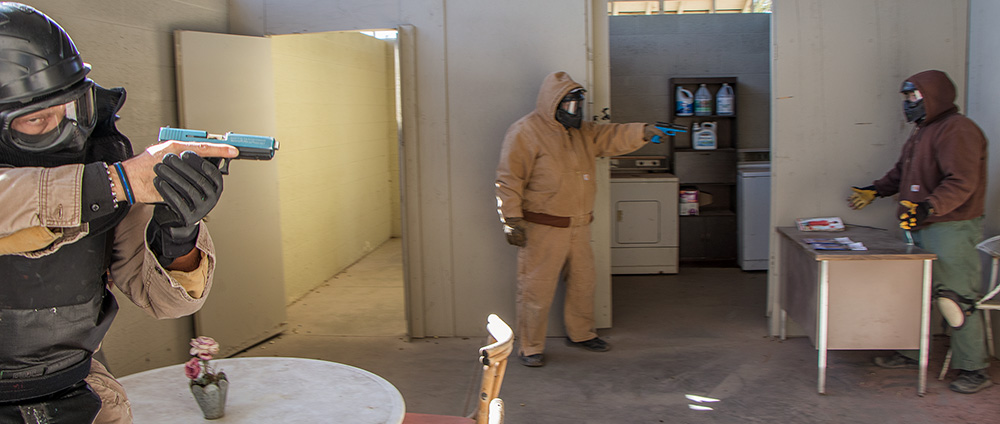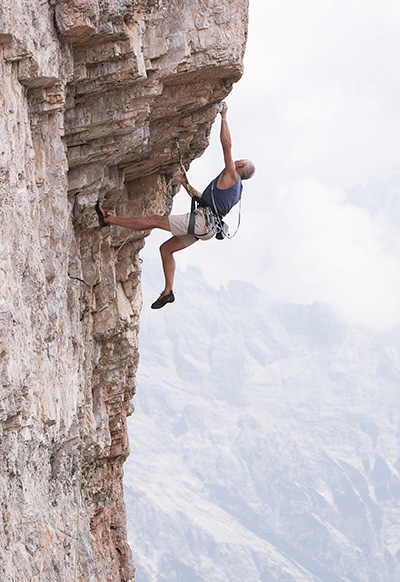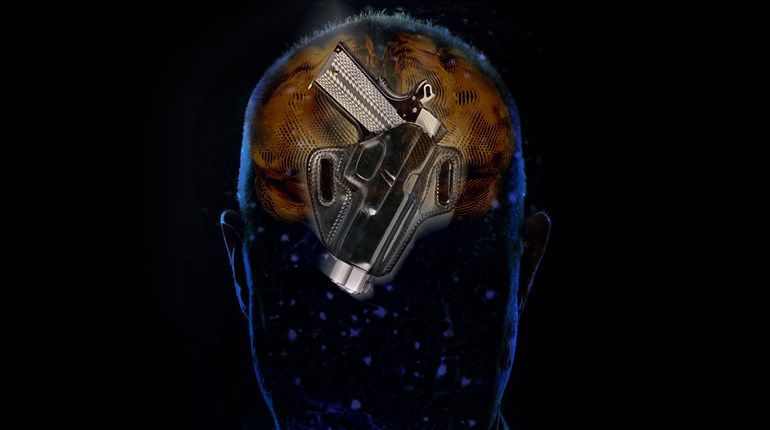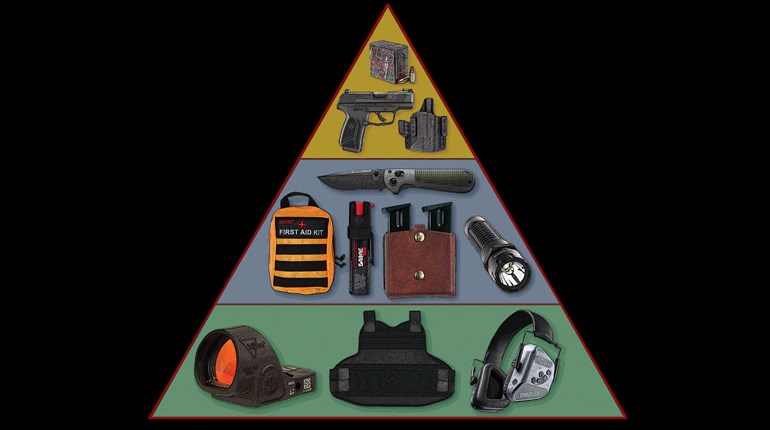
Most people are good-natured. They have no interest in harming others and are not accustomed to violence. They enjoy all life has to offer, never becoming violent. This is not to say they have not experienced fear. Our lives are peppered with countless events from big to small that trigger a fear response, which can shut down our ability to think and cause us to resort to primal instincts. These primitive responses are necessary for the survival of our species. But, are they in your best interest when it comes to self-defense with a handgun?
Evolution is a wonderful thing. It has allowed us to improve across so many spectrums. Science has paved the way to better understanding our fight-or-flight response. We’ve learned some important lessons—here are three big ones to keep in mind when it comes to self-defense: Overcoming fear has a lot to do with being exposed to it more often, understanding violence is often necessary and recognizing being violent does not make one violent.
Fear often gets a bad rap. But, there is a difference between fear and being afraid. It needs to be better understood to avoid some of the pitfalls. Fear is temporary, like being scared or startled. It happens to all of us in our lives. I can vividly recall while at a medical training course years ago how a classmate scared the life out of me—almost. It was night and dark, I was walking from the chow hall to the barracks down a dimly lit stair path. I have no idea where my mind was, but I was within eyesight of the barracks when—all of a sudden—wham! A fellow classmate jumped out of the nearby bushes. I don’t remember everything; it was more of a blur. But, another classmate sitting on the barrack’s porch saw the whole thing, as he was somewhat privy to the prank. The net result was the prankster was knocked to the ground and bloodied. What was described to me by the observer and the prankster was a huge startle response that was immediately converted into a counterattack. Without thinking, I brought my hands up, then landed a quick jab-cross combination. Who knew, but that was how my body reacted to the event. I was scared, but then again I wasn’t.
Throughout my military career, I was placed in countless situations that scared me. These situations caused me to experience the physiological effects of fear such as elevated heart rate, sweaty palms and quickened breathing, to name a few. I learned how to cope through what I considered a counterintuitive process: Do it more. If I was afraid of jumping out of airplanes, then I would jump out of them more. I once had a Master Chief blurt out at the end of the jump brief, “Remember, the moment you leave the aircraft you are dead until you save your own life by pulling your ripcord.” He literally said it as he was walking out of the briefing room, in a casual, nonchalant, over-the-shoulder manner. It took a moment for the comment to resonate with me, but it has been a life-saver in more than one way.

There are three things we can do when scared: fight, flight or freeze. Whether we acknowledge them or not, they are there. There are several ways to come to grips with fear. Being exposed to them more and more is just one, but it is one with which I am intimately familiar, and have seen the positive results firsthand. A lot has to do with how you perceive the experience in the first place. A major revelation is the acknowledgement of it being OK to be scared. Giving yourself permission to be scared is good, healthy and will help you overcome the worst effect of fear, which is paralysis. No matter the circumstances, you do have some control. Not doing anything is a form of control, if you really peel the layers back.
Being scared doesn’t mean you can’t do something. And that’s the point: Do something. Even if it seems counterintuitive, doing something helps us move forward. Moving forward, past the initial shock, gives us clarity. The duration of that initial shock is what can potentially be fatal. The longer you are in that paralysis state, the less likely you are to find a solution.
Finding safe ways to expand your comfort zone is challenging. When it comes to self-defense, one of the best methods is role-playing, meaning you are put into a situation where you must think your way out of the problem. In doing this more and more, you more quickly and effectively solve the problem. Furthermore, the body becomes more familiar with the stimulus, thus helping better prepare a response. From role-playing, you can try dynamic role-playing where the stakes are a little higher. This tends to be in the form of force-on-force or scenario-based training, which is a next-level experience that takes your experiences in role-playing and pressure tests it for success. It’s a modern form of adult roughhousing, but so much is learned from these events. The most valuable lesson is how we react—what our bodies do before, during and after.

We live in a violent world. This should not be a surprise. Every day there are countless crimes committed against innocents and, regretfully, this will never stop. When I say never, I mean never. As long as humans exist, there will always be conflict. God forbid, but you may need to confront violence with violence. I’m all for turning the other cheek, and any conflict from which you can walk away is a win in my book. That makes it even more important to have good pre-fight strategies to help detect and, if necessary, de-escalate. By being on the lookout for violent behavior, we can work to cut it off in advance. Strategies such as using purposeful action, staying calm and maintaining as much distance as the situation allows are great ideas.
Communicating effectively is another aspect we need to practice more regularly in all parts of our lives—but especially in a violent encounter. At some point the situation may escalate out of our control, and we may need to defend ourselves; and fighting for our lives most likely will require using some form of violence. As much as I object to the idea, it is possible. If all my strategies and tactics fail, which means diplomacy has failed, action is likely required. When violence is the answer, it is usually the only one.
We used the term “violence of action” to define how, as a small fighting force in the Navy, we needed to operate. It meant using the unrestricted and surgical use of speed, surprise and aggression to achieve total dominance of the situation. When it is “go time,” we need to go full throttle to make our actions so overwhelming, they create a sensory overload in our opponent engineered to either prevent or delay any action, thereby potentially thwarting the bad guy’s attack or altering the outcome in our favor.
A common obstacle for some is the notion that by using violence, you are a violent person. This couldn’t be further from the truth. On the contrary, it means you value your life, the life of your loved ones and innocent bystanders enough to exhaust all measures— including deadly force—to preserve and protect life. I go back to my earlier statement: When violence is the answer, it is usually the only answer. Your act of using violence is temporary, being violent is a condition. Violent criminal actors are, as the description states, violent by condition. They use violence to intimidate, commit crimes and terrorize. When a private citizen uses violence, they are reacting to a violent encounter. Granted, violence may be avoided, but the bad guy always gets a vote. The bad guy may choose not to cooperate or disengage; it is their choice. When left with no other options, again, violence is the only option.
The training world has evolved quite a bit, and we understand the positive and negative effects of fear better these days. Being scared or startled is a natural response, but being paralyzed is being afraid—which is something altogether different. The more we are exposed to what scares us, the better we can manage future events. Getting comfortable being uncomfortable is another way of facing fears. Despite our best intentions and actions, the violent criminal actor will always have a say in the matter. If they choose to stop the attack, great; they always have that choice. Stopping the encounter may require some form of violence. Responding to a life-threatening encounter with violence does not make one violent. It means no other options were available, the only remaining option is your last, best option to preserve and protect your life.
































